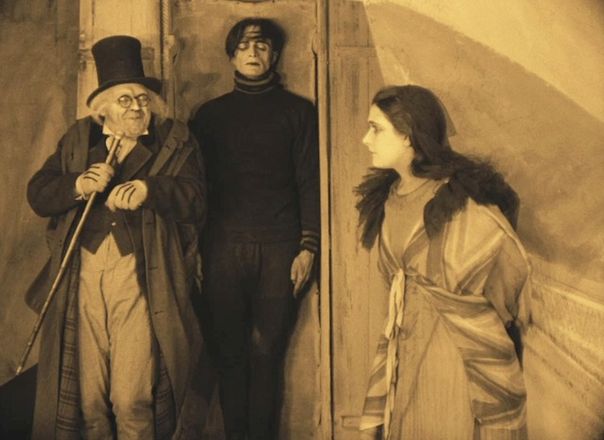A Restoration of the Silent Film Pianist’s Art
Ewa Wildner watched a restored print of the silent film classic THE CABINET OF DR. CALIGARI at the Berlin Philharmonic.

Robert Wiene's THE CABINET OF DR. CALIGARI
On one side of Potsdamer Street people crowd in front of the hotel to see George Clooney walking out of the building. The red carpet nearby leads to Berlinale Palast, which hosts prominent international premieres. But arguably, the biggest event of the first Sunday of the festival is the one being held down the street at the Berlin Philharmonic, which replaced glamour and novelty with something even more spectacular, the restored version of the classic film, THE CABINET OF DR. CALIGARI (DAS CABINET DES DR. CALIGARI, Germany).
Can anyone possibly say anything new about this film that's considered the most influential in German cinematography and a milestone in the horror genre? Well, you might say that it wouldn’t have been that successful upon its release in 1920 if John Zorn, composer of the score for the Berlinale's premiere of the newly restored version, had composed the music at the time. Motion pictures had just started to acquire the ability to scare the wits out of viewers. I can imagine that the reaction to THE CABINET OF DR. CALIGARI must have been strong in 1920, and if Zorn had been the pianist during those early screenings, the movie might have been banned so as not to cause panic attacks or destroy viewers’ nervous systems.
After a brief introduction, Zorn stepped onto the stage and sat in front of the organ, just as a silent-film musician would have done at the beginning of the 20th century – only Zorn removed his shoes. What’s more, an early 20th century organist wouldn’t have been surrounded by giant speakers and wouldn’t have had four keyboards at his disposal, in order to play different motifs at the same time. Zorn made use of the organ, which was a key to the success of CALIGARI’s modern score. Even in that score’s peaceful moments, when the gentler tones took the lead, there was always something underneath, ready to explode in the viewers’ ears when the story unfolding on the screen grew more dramatic. The tension of CALIGARI, perhaps harder to appreciate after almost a century of cinematic progress, is woken up, like Cesare the Somnambulist, to bring the audience to the edge of their seats once again.
Zorn’s music fits the story perfectly – bizarre and enhancing the peculiarity of the picture. Out of key, piercing, and raising anxiety, it sounds like a church tune performed by a devilish choir. The score emphasizes the film’s best feature from the point of view of a modern movie-goer, that is, its artificiality. Zorn's music filled the characters’ eyes with exaggerated terror, again bringing life to the grotesque setting of trees and houses cut out of cardboard. The shards of sound are drilled into the viewers’ perception like the blade of Dr. Caligari’s mysterious, murderous sleepwalker.

